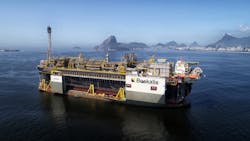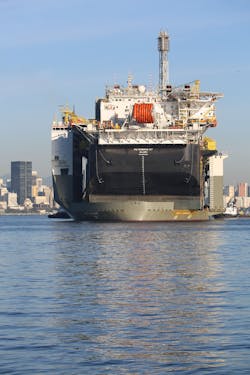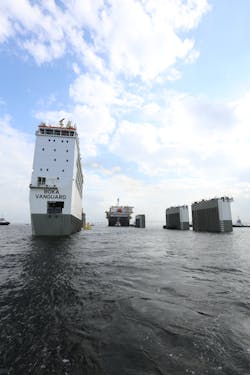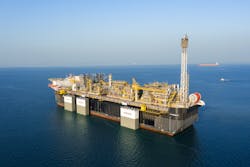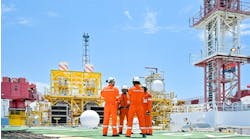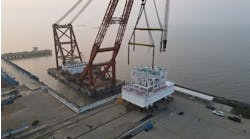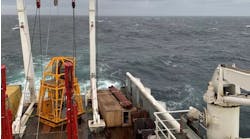Faster dry tow cuts long-haul transportation costs
Earlier this year, Boskalis’ heavy transport vessel BOKA Vanguard (formerly the Dockwise Vanguard) broke its own record for a long-distance dry transport when it delivered the 92,000-metric ton (101,412-ton) box-shaped FPSO P-70 from China to Rio de Janeiro, Brazil. The previous benchmark had been established two years earlier with the transport of the ‘sister’ vessel P-67 to the Lula Norte field in the same region.
Offshore spoke to Boskalis’ Bart Heijermans, Member of the Board of Management and Head of the Offshore Energy Division, and Pim Nelemans, Business Unit Director Heavy Marine Transport about the engineering challenges and scheduling benefits of this method of transportation for larger floating production systems.
Offshore: Was the P-67 Boskalis’ first FPSO assignment for Petrobras?
Boskalis: Transport of the P-67 was executed in 2Q 2018, and it was the first FPSO that Boskalis had delivered to Petrobras: indirectly, we had been involved in other transports and installations previously for the company. The contract scope consisted of providing the vessel in order to load, transport and discharge the FPSO. No major modifications had to be made to the Vanguard in order to transport this unit.
The main preparations for the vessel for the voyage comprised devising the cribbing plan and installing large guide frames in order to load the FPSO in a controlled manner. In addition to the transport, Boskalis provided tug assistance until the point of handover of the FPSO to the installation contractor.
In recent years we have transported various types of floaters from the Far East to the western hemisphere, ranging from a ship-shaped FPSO for BP’s Schiehallion redevelopment west of Shetland in 2016, to the circular FPSO for Eni’s Goliat project in the Norwegian Barents Sea, and the Moho Nord FPU offshore Congo for Total in 2017. Whatever the design or shape, the process of taking it onboard BOKA Vanguard is always the same, i.e. submerging the vessel’s deck to a sufficient water depth to accommodate the cargo, which is brought in using tugs and winches.
Offshore: Did Petrobras select Boskalis to transport the P-70 for Atapu based on good experiences with the Lula Norte project?
Boskalis: Petrobras chose Boskalis to transport these hulls based on the benefits a dry transport provides. The contract was signed with the Chinese fabricator (COOEC), however Petrobras’ preference for a dry-tow really helped to secure these jobs.
These are sister vessels, both of a box-shape designed by Petrobras. P-70 was a couple of hundred metric tons heavier than P-67. But because it was in most other aspects a replica of P-67, a lot of experience could be incorporated from the first job for the second FPSO transport. In addition, both the loading and discharge locations were the same and we were able to use our experiences from the loading/discharge operations for P-67 to optimize planning for the P-70, especially in the use of tugs and the anchor spread to position the FPSO during loading. The overall process was more efficient for the second job, which was one of the biggest cargoes we have ever loaded.
This was a first-time role of its type for COOEC. The hulls for the two FPSOs had been awarded and constructed and were transported to Brazil for integration of the topsides. But when the previous oil crisis of 2014-16 hit Petrobras, both hulls had to be taken back to China for the topsides integration.
Offshore: How did Boskalis state its case during tendering?
Boskalis: Our biggest challenge was convincing both Petrobras and COOEC that there were many benefits of a dry tow onboard the Vanguard. For such a long voyage, a conventional wet tow using tugs takes much longer, and around the Cape of Good Hope, where conditions are often severe, the speed becomes much slower.
With Petrobras on a very tight schedule for first oil at Lula Norte through the P-67, we convinced them that the Vanguard could carry such a big unit - weighing close to 91,000 metric tons [100,310 tons] - and that our approach could save them up to 50-60 days in sailing time compared to a wet tow.
We were contracted to pick up the platform from the shipyard in Qingdao toward the end of 2017, although the schedule ended up slipping to 2Q 2018. There is always an interplay between us and the yard in these situations, and we always make sure we have sliding windows when we can pick up and deliver the cargo. In the event, the Vanguard completed the voyage within 43 days. Compared to a wet tow this was 40-50 days faster, and it was achieved because the vessel’s average speed is around 11 knots, against 5 to 5.5 knots for a wet tow of a box-shaped FPSO.
Offshore: Did BOKA Vanguard undertake any other transport jobs between the two FPSOs for Petrobras, and did it have to undergo a major structural survey following completion of each assignment?
Boskalis: Yes, the vessel was involved in multiple voyages during the intervening period including transport of the topside platform structures for the Johan Sverdrup project from South Korea to Norway and the dry-docking of the Carnival Vista cruise vessel in the Bahamas. No major structural survey was needed in either case.
Offshore: In terms of preparations, what were the main considerations for the two Petrobras deliveries?
Boskalis: The dimensions (length and width) of the two boxed-shape FPSOs including the riser hang of structures were the main challenge. Dealing with these huge sizes and weights of cargo is always stretching the limits of vessel strength, seafastenings design, cribbing, and so on. There was a bit of overhang on the bow and stern of the Vanguard, and both cargoes just fitted in between the vessel’s accommodation block and the casings. This arrangement introduces stresses on a vessel 275 m [902 ft] long while sailing through high waves, so in some places we had below-deck reinforcements. Otherwise, it was mainly a case of managing the ballast carefully. A tailor-made cribbing plan was been designed to make sure the loads from the FPSO were spread over the whole of the vessel and introduced nicely into the vessels’ strong points.
One of the reasons Petrobras has been moving slowly away from VLCC-FPSO conversions is that if you look at the tanker’s bow, it’s not optimum because you can’t fit enough processing equipment on it. With a box-shaped FPSO, you can put more modules onto it and therefore more weight. We also have experience of transporting box-shaped floating storage and regasification units from China for Excelerate Energy to Argentina.
Offshore: Was Boskalis’ scope for the two Petrobras jobs limited to delivery of the FPSOs?
Boskalis: For the P-67 and P-70 the company was only involved with transportation. But we are keen to offer an expanded ‘one-stop-shop’ service, whether the FPSO is being transported via a dry or wet tow - the latter is something we also do for long-distance transports. Boskalis has a wide-ranging marine installation capability, including anchors, suction piles and mooring lines, that we would like to offer our customers as a way to de-risk their projects.
Offshore: Did the route around the Cape of Good Hope to southern Brazil waters present any special challenges for the two boxed-shaped FPSO transports?
Boskalis: The conditions around the CoG can be a challenge, but this also demonstrates the advantages of a dry tow versus a wet tow. Using a vessel like BOKA Vanguard makes the transport less sensitive to bad weather, because the vessel is faster and as such can change course more quickly. Another advantage is that the vessel can sail closer to shore where there is generally less severe weather than farther out at sea.
With all these deepwater project deliveries, predictability is extremely important, but it can be planned. For the dry tow of the P-70, the scheduled delivery date was January 23, and the Vanguard did indeed arrive on time. With a wet tow, the unpredictability of a long voyage is much higher, making it much harder for the client to plan activities subsequent to the vessel’s arrival.
Offshore: Has Boskalis made any changes to improve the operation and fuel economy of its transport vessels, or to monitoring motions during transit?
Boskalis: Clients always want to compare a wet tow versus a dry tow, in terms of wave impact and slamming effects. We have applied different coatings to reduce the drag resistance of the hull which in turn leads to lower fuel consumption.
Offshore: Finally, does Boskalis see any benefits of earlier engagement with companies during the FPSO project planning phase?
Boskalis: We are having some discussions with operators. If the fabricator selects a dry transport very early on, the project can be safer because the forces imposed on the FPSO during a dry tow are less than for a wet tow. And there are savings that can be made if you design the platform for a dry transport. For instance, you can continue to commission the FPSO both during the 40-50-day voyage and subsequently on arrival through first production. This is what we did on Moho Nord for Total, when more than 200 riders were onboard the Vanguard still working to complete the platform.
No commissioning was undertaken during the transports of either the P-67 or the P-70, although riders were onboard both FPSO units in order to execute the preservation scope, ensuring that the systems would start-up on arrival. •
